Osteoporosis Care
How to Use ICD Codes for Osteoporosis Screening
Yearning for insights into ICD-10 code Z13.820 for osteoporosis screening? Explore the depths of this essential coding practice and its impact on patient care.
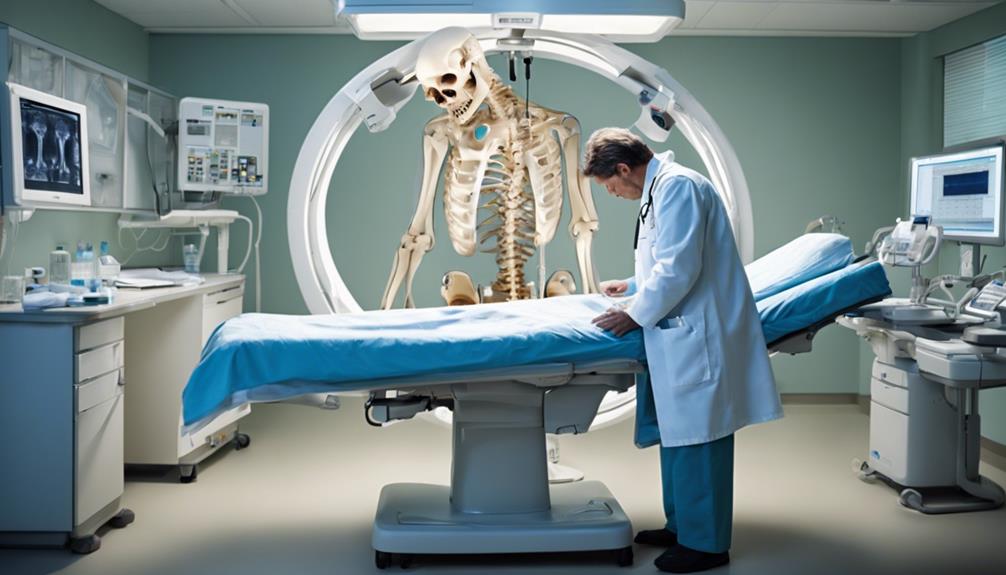
When delving into the intricate web of ICD-10 codes, one code that stands out is Z13.820, serving as a guiding light towards osteoporosis screening. Utilizing this specific code is essential in pinpointing individuals who may be susceptible to this silent threat.
But what lies beyond this code is a landscape of essential knowledge waiting to be explored. Understanding the nuances of osteoporosis screening and the significance of accurate coding is not just a task; it is a gateway to improved patient care and outcomes.
Key Takeaways
- Z13.820 is vital for accurate osteoporosis screening documentation and billing.
- Accurate diagnosis coding crucial for treatment selection and early detection.
- Proper coding ensures regulatory compliance, financial stability, and effective communication.
- Bone density scans and appropriate ICD-10 coding support osteoporosis diagnosis and treatment.
Understanding ICD-10-CM Codes for Osteoporosis
When screening for osteoporosis, healthcare providers utilize specific ICD-10-CM codes to accurately classify encounters and ensure proper billing procedures. The ICD-10-CM code Z13.820 is designated for 'Encounter for Screening for Osteoporosis' within the Z00-Z99 range, focusing on non-disease or injury circumstances. This code falls under the category of Factors Influencing Health Status and Contact with Health Services, emphasizing prevention and early detection.
It's crucial to note that Z13.820 is exclusively for osteoporosis screening and not intended for other screenings like malignant neoplasms. By employing the correct ICD-10-CM code, such as Z13.820, healthcare providers can streamline documentation processes, enhance patient care coordination, and facilitate accurate reimbursement claims.
Understanding the nuances of these codes is paramount in ensuring that patients receive appropriate preventive care and that healthcare facilities maintain compliance with billing regulations. The utilization of Z13.820 demonstrates a commitment to proactive health management and aligns with the broader goals of promoting wellness within the community.
Importance of Accurate Diagnosis Coding

Accurate diagnosis coding plays a vital role in healthcare, impacting reimbursement, compliance, and research initiatives. Ensuring precision in coding practices not only facilitates proper billing but also supports adherence to regulatory requirements.
The significance of accurate coding can't be overstated in its contribution to patient care quality and the overall efficiency of healthcare systems.
Coding Precision Impacts Reimbursement
Ensuring precise diagnosis coding is paramount for healthcare providers to secure accurate reimbursement for their services rendered. Assigning the correct ICD-10 code, Diagnosis Code, and CPT code is crucial for proper billing and reimbursement.
Coding precision directly impacts the financial stability of healthcare facilities and practices. Accurate coding minimizes the risk of claim denials, payment delays, and potential revenue loss.
Proper Coding Ensures Compliance
Precision in diagnosis coding is fundamental for healthcare providers to maintain compliance with regulations and ensure proper reimbursement for services rendered. When it comes to coding for bone health, accuracy is paramount. Here are three key points to consider:
- Correct Coding: Using the appropriate ICD-10 code for osteoporosis screening (Z13.820) is essential for accurate tracking and management of patients at risk for bone health issues.
- Ensuring Compliance: Adhering to coding guidelines for osteoporosis screening (Z13.820) supports effective communication among healthcare professionals and helps in meeting regulatory requirements.
- Enhanced Patient Care: Accurate diagnosis coding facilitates the delivery of appropriate treatment and preventive measures for patients, ultimately improving outcomes in bone health management.
Accurate Coding Aids Research
Conducting research on osteoporosis screening outcomes greatly benefits from the meticulousness of accurate diagnosis coding. Accurate coding plays a vital role in ensuring data integrity within studies focused on osteoporosis detection.
By employing proper ICD-10 coding for osteoporosis screening, researchers can effectively track and analyze screening trends, leading to more reliable insights. Healthcare providers and researchers rely on precise diagnosis codes to evaluate the efficacy of screening programs.
Consistent and accurate coding practices are essential for supporting evidence-based decision-making in osteoporosis screening initiatives. The reliability of the data collected hinges on the accuracy of the codes used, emphasizing the importance of meticulous coding procedures in advancing research efforts related to osteoporosis screening.
Benefits of Proper Documentation

Proper documentation plays a crucial role in ensuring the accuracy of osteoporosis screening encounters. It not only supports precise billing and coding but also aids in tracking patient history and monitoring osteoporosis risk effectively.
Clear documentation is essential for justifying the necessity of screening services and enhances communication among healthcare providers, ultimately improving patient care.
Importance of Accuracy
Ensuring accurate documentation of osteoporosis screening with ICD-10 codes, such as Z13.820, is crucial for facilitating proper billing and reimbursement processes in healthcare settings. Precision in coding supports early detection and management of bone health issues, aiding in identifying individuals at risk for osteoporosis.
- Targeted Treatment:
Proper documentation enables healthcare providers to choose appropriate interventions based on screening results, ensuring individuals receive the necessary care promptly.
- Efficient Tracking:
Utilizing the correct ICD-10 code Z13.820 promotes efficient tracking and monitoring of bone density over time, allowing for effective follow-up and management.
- Enhanced Patient Care:
Detailed records help in providing personalized care, improving outcomes, and enhancing the overall patient experience.
Legal Compliance Assurance
Transitioning from the importance of accuracy in osteoporosis screening documentation, maintaining precise records not only supports optimal patient care but also ensures legal compliance with healthcare regulations and standards. Proper documentation, such as using the ICD-10-CM Z codes for Encounter for screening, is essential for providing high-quality health services.
Detailed records not only reduce the risk of billing errors and potential audits but also aid in defending against malpractice claims. Compliance with documentation guidelines is crucial for tracking patient outcomes and monitoring the effectiveness of interventions. By adhering to these standards, healthcare providers can uphold the integrity of their practice while delivering comprehensive care to patients.
Improved Patient Care
Improving patient care through meticulous documentation of osteoporosis screening results is crucial for enhancing healthcare outcomes and treatment effectiveness. Proper documentation can significantly benefit patient health by:
- Influencing Health Status: Detailed records aid in assessing the progression of osteoporosis, guiding healthcare providers in making informed decisions to improve patient health.
- Early Detection of Malignant Neoplasms: Accurate documentation allows for the identification of potential secondary health concerns like malignant neoplasms, enabling timely intervention and improved patient outcomes.
- Enhancing Treatment Plans: Comprehensive documentation supports the development of tailored treatment plans, optimizing patient care and promoting overall health and well-being.
Relevance of Z13.820 Code

The Z13.820 code plays a crucial role in facilitating accurate billing and reporting for osteoporosis screening encounters. This specific code falls under the category of Factors Influencing Health Status and Contact with Health Services, making it a fundamental tool for healthcare providers.
When documenting encounters related to osteoporosis screening, the Z13.820 code ensures proper reimbursement and compliance with coding guidelines. It's indexed under contact with health services, emphasizing its significance in reflecting the health status of patients undergoing osteoporosis screening.
Moreover, exempt from reporting the Present on Admission (POA) indicator, this code is essential for detailing encounters while being grouped within MS-DRG v41.0 for appropriate billing.
Common ICD-10 Codes for Osteoporosis

As we explore common ICD-10 codes for osteoporosis, it's crucial to understand the significance of accurate diagnosis coding. These codes, such as Z13.820, play a pivotal role in identifying individuals at risk for osteoporosis and ensuring appropriate treatment selection.
ICD-10 Diagnosis Codes
During osteoporosis screening encounters, healthcare providers utilize the ICD-10 code Z13.820 for billing and coding purposes. This code is specifically designed for encounters related to screening for osteoporosis, aiding in accurate documentation and reimbursement.
Here are three key points regarding the use of ICD-10 diagnosis codes for osteoporosis:
- Z13.820 Prevalence**: In 2021, Z13.820 accounted for 14.40% of osteoporosis diagnoses among the top 10 ICD-10 codes.
- Importance of Early Detection: Osteoporosis screening is crucial for early detection and effective management of bone health issues.
- Coding Classification**: Z13.820 falls under the Factors Influencing Health Status and Contact with Health Services category in ICD-10-CM, streamlining the coding process for healthcare providers.
Osteoporosis Screening Guidelines
Utilizing common ICD-10 codes like Z13.820, M81.0, and M81.8 is essential for accurate osteoporosis screening guidelines. These codes help healthcare providers document encounters related to osteoporosis screening effectively.
Screening for osteoporosis typically involves a bone density scan, also known as a DEXA scan, to evaluate bone health. Z13.820 falls under the Factors Influencing Health Status and Contact with Health Services ICD-10 range, specifically for encounter screening for osteoporosis.
Properly assigning ICD-10 codes such as these is crucial for ensuring appropriate reimbursement and tracking of osteoporosis screenings. By adhering to these guidelines and using the correct codes, healthcare professionals can enhance the quality of care provided to individuals undergoing osteoporosis screening.
Coding for Bone Density
Efficient coding with appropriate ICD-10 and CPT codes is crucial for accurately documenting bone density testing for osteoporosis diagnosis and treatment planning.
When coding for bone density, remember the following:
- Use ICD-10 code Z13.820 for osteoporosis screening encounters to identify individuals at risk.
- Utilize common CPT code 77080 for bone density testing to support the diagnosis of osteoporosis.
- Accurate coding ensures proper billing and helps healthcare providers select suitable treatments based on diagnostic results.
Proper documentation supports effective care and management of osteoporosis.
Coding for Musculoskeletal Screenings

Musculoskeletal disorder screenings are accurately coded using the ICD-10 code Z13.8 in healthcare billing processes. Specifically, for screening for osteoporosis, the code Z13.820 is utilized. This code falls under the broader category of Z13.8, which encompasses various musculoskeletal screenings.
Healthcare providers rely on this specific code for precise billing and coding purposes related to musculoskeletal health assessments. It's essential to note that Z13.820 is billable and holds a Present on Admission (POA) exemption status, streamlining the reimbursement process for these screenings.
Coding for Other Specified Diseases
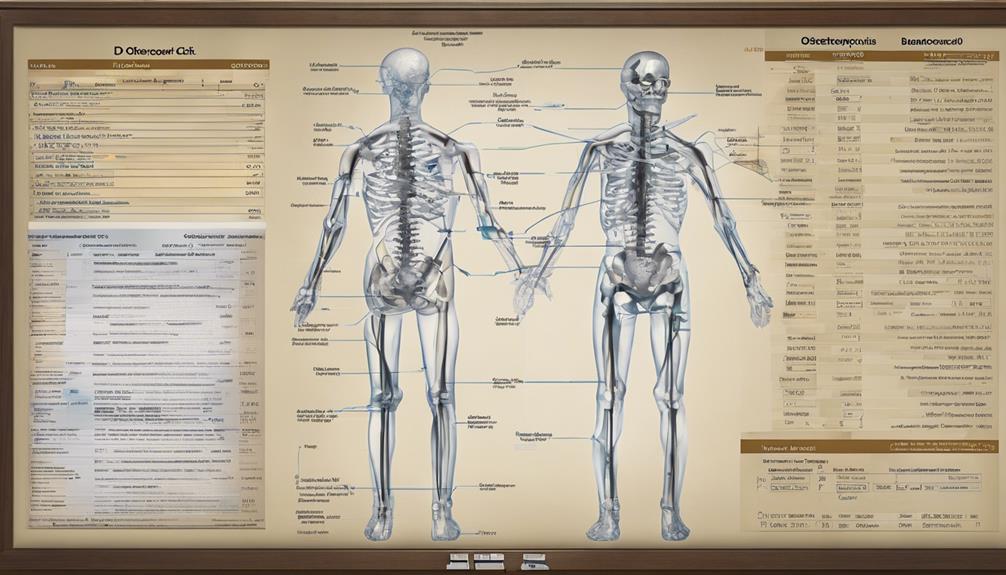
Our focus now shifts to the accurate coding of other specified diseases within the healthcare billing system, ensuring comprehensive documentation for various health assessments and screenings.
- Specific Coding Guidelines: When assigning codes for other specified diseases, it's crucial to follow the specific guidelines provided in the ICD-10-CM manual. These guidelines offer detailed instructions on how to accurately code for conditions that don't have a unique code.
- Documentation Importance: Comprehensive documentation is key when coding for other specified diseases. Healthcare providers need to ensure that all relevant information, including the nature of the disease, diagnostic test results, and any associated symptoms, is clearly documented to support the assigned code.
- Code Selection Accuracy: Selecting the most appropriate code for an unspecified disease is essential for accurate billing and reimbursement. It's important to review the code descriptions and guidelines carefully to determine the best-fitting code based on the patient's specific condition and symptoms.
Unspecified Screening Encounters

Screening encounters for unspecified conditions play a crucial role in preventive healthcare efforts and early detection strategies. When it comes to ICD-10 coding, encounters for unspecified screening can help healthcare providers identify potential health issues before they progress.
While specific diagnosis codes provide detailed information, unspecified codes like Z13.820 allow for a broader approach to screening, covering various conditions under a single code. In the case of osteoporosis screening, using Z13.820 streamlines the coding process and ensures that patients receive the necessary preventive care.
These encounters fall under the Factors influencing health status and contact with health services category, emphasizing the importance of proactive healthcare management. By utilizing unspecified screening encounters, healthcare professionals can efficiently track and monitor patients' health status, leading to early interventions and improved health outcomes.
Top Diagnosed ICD-10 Codes

What were the most frequently diagnosed ICD-10 codes for osteoporosis in 2021 based on the data provided?
Here are the top three ICD-10 codes:
- M810 (Age-related osteoporosis without current pathological fracture): This code was the most diagnosed ICD-10 code for osteoporosis in 2021, indicating a significant prevalence of age-related osteoporosis without current pathological fractures.
- Z13.820 (Encounter for screening for osteoporosis): Despite being the second most diagnosed ICD-10 code, Z13.820 accounted for 14.40% of all osteoporosis diagnoses in 2021, highlighting the importance of screening for this condition.
- Other top ICD-10 codes: The top 10 ICD-10 codes for osteoporosis collectively had an average of 898,013 diagnoses in 2021, with a total of 8,980,128 osteoporosis diagnoses captured by these top codes. This data underscores the widespread impact of osteoporosis and the need for effective screening and management strategies.
Diagnosis Code Analysis

In examining the diagnosis code analysis for osteoporosis, it's crucial to understand the significance of ICD-10-CM code Z13.820 for screening purposes and its implications in healthcare management. This specific code, Z13.820, is designated for encounters related to screening for osteoporosis. It plays a vital role in reimbursement processes and has been effective since October 1, 2023, in the 2024 edition of ICD-10-CM. Falling under the Factors Influencing Health Status and Contact with Health Services category, this code allows healthcare providers to document and track osteoporosis screening accurately.
Worth noting is that screening for osteoporosis is exempt from Present on Admission (POA) reporting requirements. As part of the ICD-10-CM range for 2024, the Z13.820 code caters specifically to screening for osteoporosis, enabling healthcare professionals to manage this aspect of patient care efficiently and effectively.
Osteoporosis Screening Overview

Let's start the discussion on the 'Osteoporosis Screening Overview' by highlighting the importance of screening for this condition.
Osteoporosis screening is crucial for early detection and effective management of the disease.
Understanding the recommended age for screening can aid healthcare providers in offering timely interventions.
Screening Importance
An essential aspect of osteoporosis screening involves utilizing bone density scans like DEXA to evaluate and monitor bone health for early detection of potential issues.
Screening for osteoporosis is essential for several reasons:
- Identifying individuals at risk: Screening helps to identify individuals who are at risk for osteoporosis-related fractures, allowing for proactive management.
- Facilitating timely intervention: Early detection through screening enables timely intervention and treatment, reducing the risk of complications associated with osteoporosis.
- Monitoring bone health: Regular screening allows healthcare providers to monitor changes in bone density over time, guiding personalized treatment plans for better outcomes.
Recommended Age
Engaging in osteoporosis screening at the recommended age marks a crucial step towards proactive bone health management and early intervention. For women, screening is typically advised at age 65 and older, while for men, the recommended age is 70 and older.
However, postmenopausal women under 65 with certain risk factors should also consider screening. Men between 50-69 with specific risk factors should have a discussion with their healthcare provider regarding screening. Additionally, individuals who've experienced fractures after the age of 50 should contemplate undergoing osteoporosis screening.
It's important to note that screening intervals may vary depending on individual risk factors and test results, emphasizing the need for personalized care in osteoporosis management.
Diagnostic Process for Osteoporosis
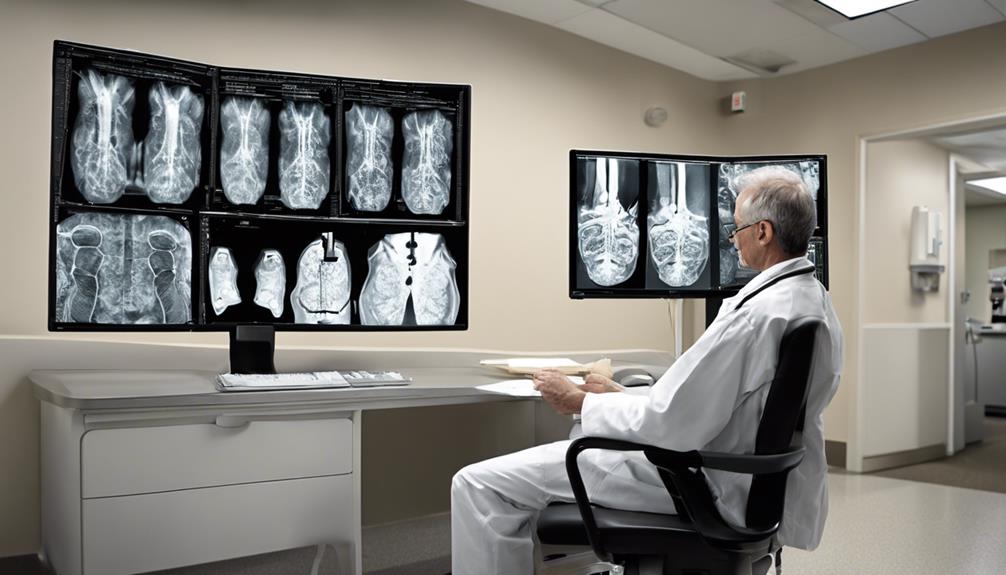
In diagnosing osteoporosis, the primary method utilized is a bone density scan known as a DEXA scan. This non-invasive procedure measures bone mineral density and compares it to the bone density of a healthy young adult, providing a T-score that indicates bone health.
Here are three key aspects of the diagnostic process for osteoporosis:
- Interpreting T-Score: A T-score of -2.5 or lower on a DEXA scan is considered indicative of osteoporosis. This measurement reflects the number of standard deviations below the average bone density of a young adult.
- Assessing Fracture Risk: Beyond bone density, healthcare providers assess other factors like age, gender, medical history, and lifestyle to evaluate the overall risk of fractures and the need for further testing or treatment.
- Monitoring Bone Health: Regular bone density testing helps track changes in bone strength over time, enabling early detection of bone loss and facilitating timely interventions to prevent fractures and manage osteoporosis effectively.
Treatment Options for Osteoporosis

After assessing fracture risk and bone health through diagnostic measures like DEXA scans, individuals diagnosed with osteoporosis can explore various treatment options aimed at strengthening bones and reducing fracture risk.
Medication therapy plays a central role in managing osteoporosis, with options including bisphosphonates, denosumab, teriparatide, and raloxifene. These medications work to increase bone density and reduce the risk of fractures.
Additionally, modifying risk factors such as ensuring adequate calcium and vitamin D intake is crucial in managing osteoporosis effectively. Lifestyle changes, including incorporating weight-bearing exercises like walking or resistance training, and implementing fall prevention strategies, are essential components of osteoporosis treatment.
In severe cases, advanced treatments like biologic medications or hormone therapy may be considered. Regular monitoring and follow-up with healthcare providers are vital to assess treatment effectiveness, make any necessary adjustments, and ensure optimal bone health outcomes.
Impact on Patient Care

Screening for osteoporosis with ICD-10-CM coding significantly impacts patient care by enabling early detection and management of bone density issues. This proactive approach to healthcare ensures that individuals at risk for osteoporosis receive timely interventions, leading to improved outcomes and quality of life. The impact on patient care is profound, with the following key benefits:
- Early Intervention: By identifying individuals with low bone density early on, healthcare providers can initiate appropriate treatments promptly, potentially preventing fractures and other complications associated with osteoporosis.
- Customized Care Plans: Accurate ICD-10-CM coding allows for the development of personalized care plans tailored to each patient's specific needs, ensuring comprehensive management of osteoporosis and associated risk factors.
- Enhanced Follow-Up: With proper coding for osteoporosis screening, healthcare teams can schedule regular follow-up appointments to monitor bone health, adjust treatments as necessary, and provide ongoing support to patients in managing their condition effectively.
Frequently Asked Questions
What Is the ICD-10 Code for Screening for Osteoporosis?
We know the ICD-10 code for screening for osteoporosis is Z13.820. It's essential to use this specific code for encounters related to osteoporosis screening. This code falls under the Factors Influencing Health Status and Contact with Health Services category.
Using Z13.820 ensures accurate medical record keeping and facilitates reimbursement processes. Early detection through osteoporosis screening is crucial for effective management of the condition.
What ICD-10 Code Should I Use for a DEXA Scan?
When using a DEXA scan, the appropriate ICD-10 code to document the procedure is Z13.820. This code is crucial for accurate billing and coding, aiding in the identification of individuals at risk for osteoporosis through bone density testing.
What Is the Age Limit for Z13 820?
We don't have a specific age limit for the Z13.820 code used in osteoporosis screening. This code is versatile and can be applied to individuals of all ages undergoing osteoporosis screening.
It plays a crucial role in identifying and monitoring osteoporosis risk across different age groups. Providers can utilize Z13.820 without age restrictions for their osteoporosis screening encounters, ensuring comprehensive care for patients at varying stages of life.
What Is the ICD-10 Code for Z78.0?
We eagerly share that the ICD-10 code for Z78.0 is notably utilized for osteoporosis screening encounters. This code, falling under Factors Influencing Health Status and Contact with Health Services, is crucial for accurate billing and coding.
Conclusion
In conclusion, accurate coding and documentation are essential in the screening and management of osteoporosis. As the saying goes, 'an ounce of prevention is worth a pound of cure.'
By utilizing the Z13.820 code and other relevant ICD-10 codes, healthcare providers can ensure that individuals at risk for osteoporosis receive timely interventions and appropriate care. This proactive approach can ultimately lead to improved patient outcomes and quality of life.
Osteoporosis Care
How to Use ICD Code for Osteoporosis Screening
Wondering how to accurately code osteoporosis screenings? Uncover the key to early detection and optimal patient care outcomes with the ICD-10 code Z13.820.

Did you know that approximately 200 million people worldwide are affected by osteoporosis? It is crucial to understand the importance of early detection in combating this disease.
By utilizing the correct ICD-10 code for osteoporosis screening, healthcare providers can ensure proper identification of at-risk individuals and facilitate timely management strategies. But what are the specific guidelines for coding osteoporosis screenings, and how can accurate documentation impact patient care outcomes?
Let's explore the intricacies of using the ICD-10 code Z13.820 for osteoporosis screening encounters and delve into the broader implications of effective coding practices in promoting bone health.
Key Takeaways
- Early detection crucial for combating osteoporosis.
- Regular screening identifies at-risk individuals.
- Tailored treatments based on screening results.
- Coding accuracy vital for billing and reimbursement compliance.
Overview of Osteoporosis Screening ICD-10 Code
When considering osteoporosis screening, healthcare providers utilize the ICD-10-CM code Z13.820 for effective identification and management. This specific code, effective from October 1, 2023, in the 2024 edition, falls under the Factors Influencing Health Status and Contact with Health Services category. It's designated for the encounter for screening for osteoporosis. One key advantage of using the Z13.820 code is that it's exempt from Present on Admission (POA) reporting, streamlining the documentation process for healthcare professionals. Moreover, this code is grouped within MS-DRG v41.0, facilitating proper categorization and billing procedures.
Understanding the nuances of the ICD-10-CM code Z13.820 is crucial for healthcare providers aiming to screen for osteoporosis efficiently. By accurately utilizing this code, practitioners can ensure that patients receive timely and appropriate screening measures, leading to early detection and management of osteoporosis. Mastering the application of Z13.820 in clinical practice empowers healthcare teams to deliver comprehensive care while adhering to standardized coding protocols.
Importance of Early Detection

Early detection saves lives by identifying osteoporosis before serious complications like fractures occur.
Screening improves outcomes by allowing for timely interventions and treatments.
Prevention is key in managing osteoporosis and reducing risks associated with bone density loss.
Early Detection Saves Lives
Screening for osteoporosis plays a vital role in preventing fractures and complications by identifying individuals at risk of bone loss and fractures. Early detection through screening is crucial as it allows for timely intervention and management to prevent further bone deterioration.
Detecting osteoporosis early not only helps in recommending appropriate treatment but also enables healthcare providers to suggest necessary lifestyle modifications. Regular screening, particularly for postmenopausal women and older adults, is recommended to assess bone health accurately.
Screening Improves Outcomes
Enhancing health outcomes and reducing the impact of osteoporosis hinges significantly on timely identification through comprehensive screening methods. Screening plays a vital role in detecting osteoporosis early, enabling healthcare providers to intervene before complications arise.
By conducting regular screening tests, such as bone density scans, individuals at risk can be identified, allowing for the implementation of appropriate interventions to prevent fractures and bone density loss. Timely screening not only helps in the management of osteoporosis but also improves the overall quality of life for those affected.
Through screening, healthcare professionals can tailor treatment plans, monitor bone health effectively, and ultimately reduce the risk of fractures associated with osteoporosis, leading to better health outcomes.
Prevention Is Key
The key to effective prevention of osteoporosis lies in timely detection and intervention through comprehensive screening methods. Utilizing the ICD-10-CM code Z13.820 for screenings can help identify individuals at risk for fractures and bone health issues, enabling prompt interventions and management strategies. By encouraging regular osteoporosis screenings with this specific code, individuals can take proactive steps towards implementing lifestyle modifications and appropriate treatments to prevent complications associated with osteoporosis. This approach not only improves overall bone health but also enhances the quality of life for those at risk. Take a look at the table below for a quick overview of the benefits of early detection through osteoporosis screenings:
| Benefits of Osteoporosis Screening with ICD-10 Code Z13.820 |
|---|
| Identifies individuals at risk for fractures |
| Enables timely interventions and management |
| Facilitates implementation of lifestyle modifications |
| Guides appropriate treatments |
| Improves overall bone health and quality of life |
Coding Guidelines for Osteoporosis Screening

Let's start by discussing the coding guidelines for osteoporosis screening. Understanding the coding guidelines is crucial for accurate documentation and reimbursement.
We'll cover an overview of the guidelines and explain the criteria for reimbursement to ensure healthcare providers are well-informed.
Coding Guidelines Overview
Considering the importance of accurate coding for healthcare services, understanding the coding guidelines for osteoporosis screening is crucial for proper documentation and reimbursement.
- Assign ICD-10-CM code Z13.820 for 'Encounter for screening for osteoporosis.'
- Remember that Z13.820 belongs to the Factors Influencing Health Status and Contact with Health Services category.
- Utilize Z13.820 for billing and reimbursement purposes related to osteoporosis screening.
- Note that Z13.820 is within the Z00-Z99 range in the ICD-10-CM coding system.
Reimbursement Criteria Explanation
To ensure proper reimbursement for osteoporosis screening, understanding the criteria outlined in the coding guidelines is essential. The ICD-10-CM code Z13.820, effective from October 1, 2023, in the 2024 edition, is crucial for reimbursement purposes. This code, categorized under Factors Influencing Health Status and Contact with Health Services, specifically denotes the encounter for screening for osteoporosis. Importantly, Z13.820 is exempt from Present on Admission (POA) reporting and is grouped within MS-DRG v41.0.
Familiarizing oneself with the nuances of this code ensures accurate reimbursement for osteoporosis screening procedures, facilitating efficient healthcare service provision. Stay informed about the specific requirements and guidelines associated with ICD-10-CM Z13.820 to optimize reimbursement processes and support quality patient care.
Commonly Used ICD-10 Code
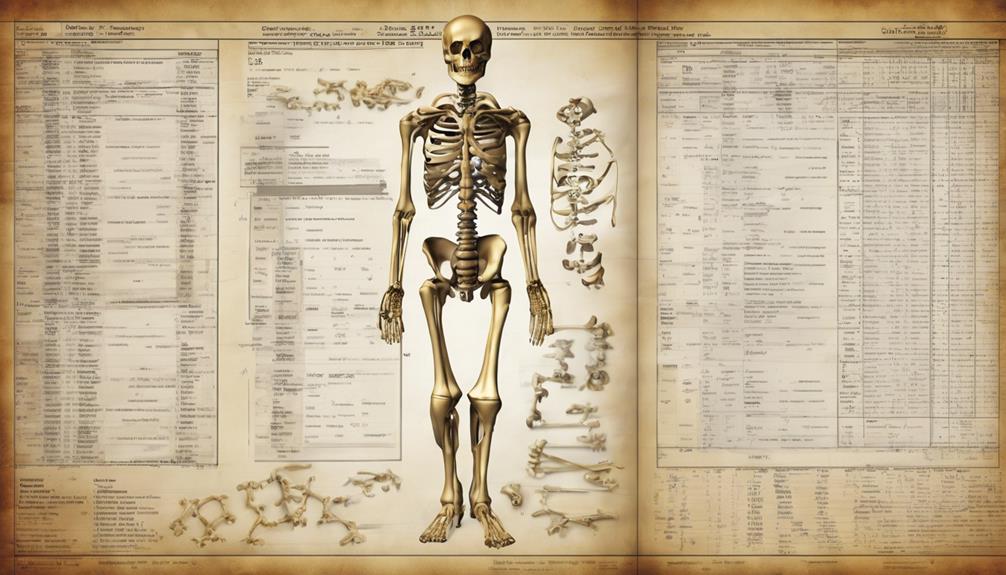
The commonly used ICD-10 code for osteoporosis screening is Z13.820, specifically designated for encounters related to screening for osteoporosis. When it comes to coding for bone density tests and osteoporosis screening, accuracy is crucial.
Here are some key points to consider:
- Identification: Z13.820 helps healthcare providers identify individuals at risk for osteoporosis through screening procedures.
- Proper Billing: Using the correct ICD-10 code ensures proper billing and coding during screenings for bone density, facilitating reimbursement processes.
- Treatment Selection: Accurate coding with Z13.820 aids in documenting the necessity for bone density tests, leading to appropriate treatment selections.
- Documentation: Proper documentation supported by the use of Z13.820 is essential for maintaining a comprehensive record of osteoporosis screening and bone health evaluations.
Documentation Tips for Accurate Coding

For accurate coding of osteoporosis screening encounters, meticulous documentation is essential to ensure proper ICD-10 code selection and billing accuracy. When documenting these encounters, it is crucial to specify the reason for the screening, including factors like age, risk factors, or family history. Additionally, documenting the screening method employed, such as a DEXA scan, provides vital context for accurate code selection. Mentioning any findings or results from the screening process in the documentation is also crucial for precise code assignment. It is important to consistently update and maintain detailed records of all osteoporosis screening encounters to ensure coding continuity and accuracy.
| Documentation Tips for Accurate Coding | Examples |
|---|---|
| Specify reason for screening | Age, risk factors, family history |
| Document screening method used | DEXA scan, ultrasound |
| Include findings/results from screening | T-score results, fracture risk assessment |
Reimbursement Considerations

Navigating the complexities of reimbursement for osteoporosis screening involves understanding the specific ICD-10 code Z13.820 designated for this purpose, effective in the 2024 edition of ICD-10-CM. When considering reimbursement for osteoporosis screening with Z13.820, here are some key points to keep in mind:
- Coding Accuracy: Ensure proper use of Z13.820 to accurately reflect the purpose of the encounter for osteoporosis screening.
- Reimbursement Rates: Familiarize yourself with the reimbursement rates associated with osteoporosis screening under Z13.820 to optimize billing.
- Coverage Policies: Stay informed about insurance coverage policies regarding osteoporosis screening to avoid claim denials.
- Documentation Requirements: Maintain thorough documentation supporting the necessity of osteoporosis screening to substantiate claims and facilitate reimbursement processing.
Understanding these reimbursement considerations related to ICD-10 code Z13.820 is essential for healthcare providers seeking proper compensation for osteoporosis screening services.
Diagnosis Code Z13.820 Details
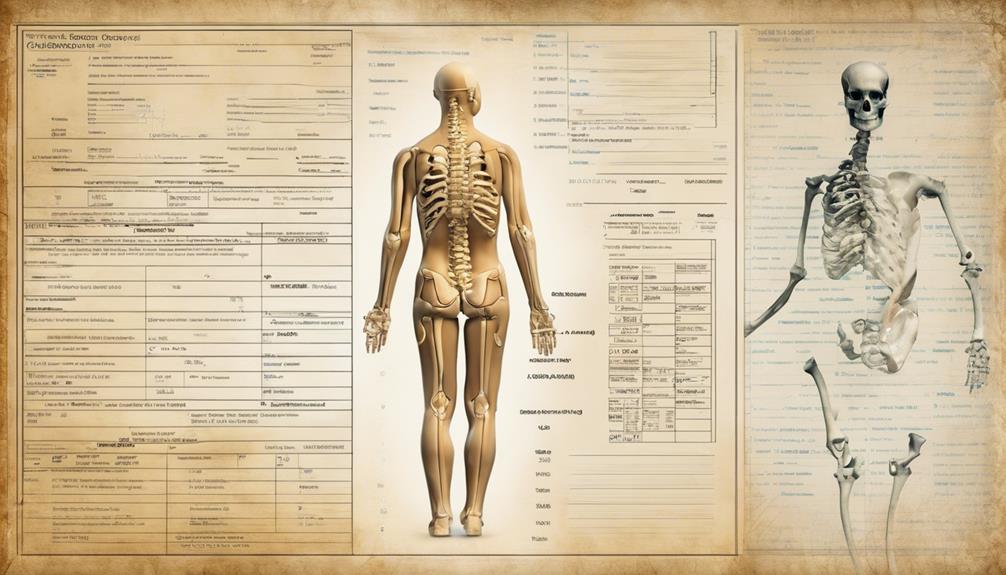
Let's explore the key points related to Diagnosis Code Z13.820.
We'll discuss the importance of osteoporosis screening, provide an overview of risk factors, and summarize screening guidelines.
These details are crucial for healthcare professionals to accurately document and code encounters for osteoporosis screening.
Screening Importance Explained
Understanding the importance of osteoporosis screening is crucial for identifying individuals at risk and ensuring accurate billing and coding using diagnosis code Z13.820.
- Early Detection: Osteoporosis can be asymptomatic until a fracture occurs; screening allows for early detection.
- Guiding Treatment: Screening results, often obtained through a DEXA scan, guide healthcare providers in determining appropriate treatment plans.
- Preventive Measures: Identifying individuals at risk enables the implementation of preventive measures to reduce the likelihood of fractures.
- Healthcare Cost Reduction: Early identification and management of osteoporosis can lead to reduced healthcare costs associated with treating fractures.
Screening for osteoporosis through Z13.820 not only aids in early detection but also plays a significant role in preventive care and cost-effective healthcare management.
Risk Factors Overview
Screening for osteoporosis through diagnosis code Z13.820 is crucial for identifying individuals at risk based on specific factors such as age, gender, family history, and lifestyle choices that can impact bone health.
Factors such as age play a significant role, with women over 50 and men over 70 being at higher risk. Additionally, behaviors like low calcium intake, vitamin D deficiency, smoking, and excessive alcohol consumption can increase the likelihood of developing osteoporosis.
Sedentary lifestyles, long-term steroid use, and low body weight are also factors that can make individuals more susceptible to this condition. Early detection through an encounter for screening is essential to prevent fractures and effectively manage bone health in those at risk.
Screening Guidelines Summary
In the realm of osteoporosis screening, the diagnosis code Z13.820 serves as a crucial tool for identifying individuals at risk based on specific factors such as age, gender, family history, and lifestyle choices impacting bone health. When considering screening guidelines summarized under ICD-10-CM Z13.820, we focus on:
- Using this code for encounters specifically aimed at screening for osteoporosis.
- Placing Z13.820 under Factors Influencing Health Status and Contact with Health Services.
- Knowing that this code is exempt from Present on Admission (POA) reporting requirements.
- Understanding that Z13.820 falls within the Z00-Z99 range for non-disease or injury circumstances in the 2024 ICD-10-CM edition.
These guidelines are essential for accurate billing and coding during osteoporosis screening encounters.
Frequency of Osteoporosis Screenings
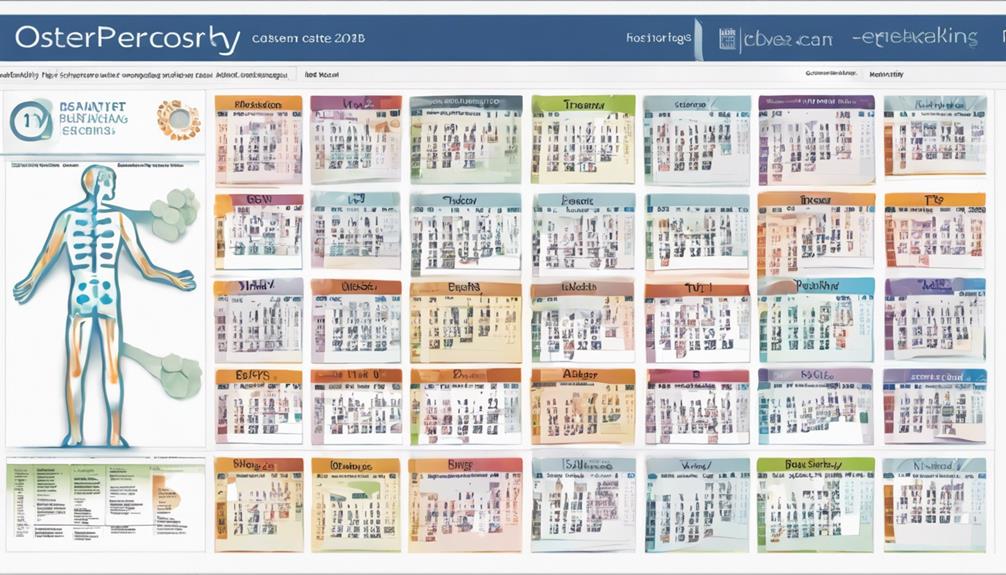
For individuals at increased risk, the frequency of osteoporosis screenings is crucial in maintaining bone health and preventing complications. Osteoporosis screenings are recommended for women aged 65 and older and men aged 70 and older as part of routine preventive care. However, individuals with risk factors such as fractures, low body weight, or a family history of osteoporosis may need screenings earlier. Bone density tests, like DEXA scans, are commonly used for osteoporosis screening due to their accuracy in measuring bone strength.
The intervals at which screenings should occur can vary based on individual risk factors and initial test results. Generally, if initial screenings are normal, repeating the test every two years may be sufficient. For those with abnormal results or higher risks, more frequent screenings may be necessary to monitor bone health closely. Early detection through regular screenings enables healthcare providers to intervene promptly and implement preventive measures to reduce the risk of fractures and complications associated with osteoporosis.
Coding Challenges and Solutions
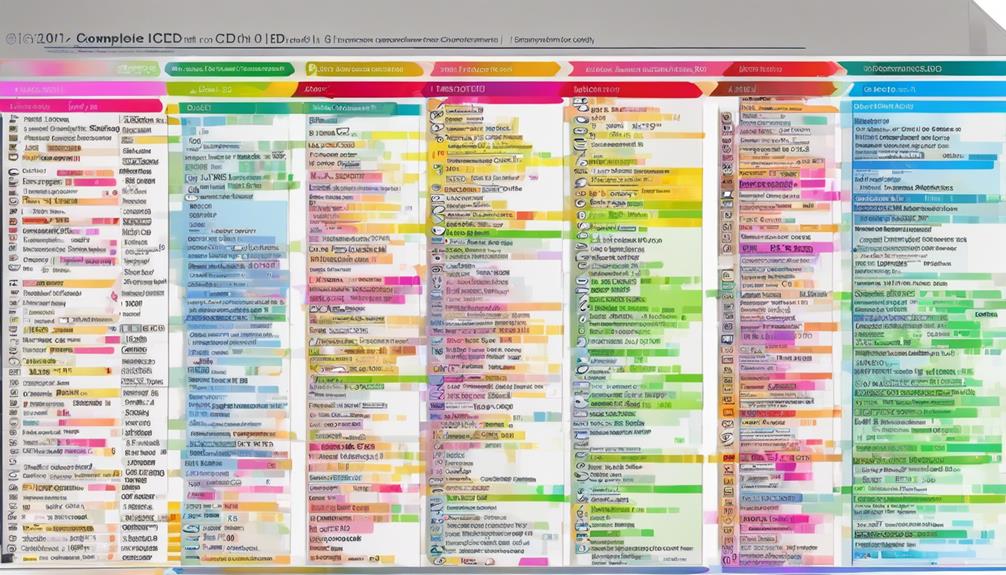
Navigating the complexities of coding for osteoporosis screenings can present challenges, yet understanding the nuances of ICD-10 codes like Z13.820 is essential for accurate documentation and reimbursement. When dealing with the ICD-10-CM code for osteoporosis screening, there are specific challenges that healthcare professionals may encounter, along with solutions to address them:
- Code Specificity: Ensuring that the Z13.820 ICD-10 code is used solely for osteoporosis screening and not for other conditions requiring screening is crucial for proper documentation.
- Documentation Clarity: Providing detailed documentation of the screening process and results can help support the medical necessity of the procedure, leading to appropriate reimbursement.
- Coding Compliance: Staying updated on any revisions or additions to the ICD-10-CM coding system related to osteoporosis screenings is vital to maintain accurate coding practices.
- Educational Outreach: Conducting training sessions for staff members involved in coding to enhance their understanding of the nuances of ICD-10-CM coding for osteoporosis screenings can improve coding accuracy and efficiency.
Future Trends in Osteoporosis Coding

Exploring potential advancements in osteoporosis coding reveals a landscape of evolving guidelines and technologies. Updates to screening guidelines and recommendations are anticipated to enhance the accuracy of osteoporosis diagnosis.
Advancements in technology hold the promise of more precise diagnostic tools for osteoporosis screening, leading to improved patient outcomes. Changes in healthcare policies and reimbursement models may influence how osteoporosis screening is coded and billed, necessitating ongoing collaboration between healthcare providers and coding experts to ensure accurate documentation and coding practices.
Furthermore, ongoing research in the field of osteoporosis may prompt the introduction of new diagnostic examination codes or modifications to existing codes for better identification and management of the condition. Staying abreast of these future trends is crucial for healthcare professionals to effectively navigate the evolving landscape of osteoporosis coding and provide quality care to patients in need.
Frequently Asked Questions
What Is the CPT Code for Osteoporosis Screening?
The CPT code for osteoporosis screening using a dual-energy X-ray absorptiometry (DEXA) scan is 77080.
This code is essential for bone density studies to screen and monitor osteoporosis, helping healthcare providers assess bone health and fracture risk accurately.
Proper use of CPT code 77080 ensures correct coding and billing, facilitating appropriate reimbursement for osteoporosis screening services.
What Diagnosis Code Should Be Used for a Bone Density Test?
For a bone density test, the appropriate diagnosis code to use is Z13.820.
This code is crucial for accurately billing and coding the screening process and helps healthcare providers identify individuals at risk for osteoporosis.
By ensuring the correct diagnosis code is used, we can promote early detection and proper management of osteoporosis through timely bone density tests.
Z13.820 is key to selecting the right treatment for bone health.
What Is the Age Limit for Z13 820?
We want to clarify that there's no age limit for ICD-10-CM code Z13.820 when it comes to osteoporosis screening. This code is meant for anyone undergoing such screening, regardless of age.
Healthcare providers have the flexibility to use Z13.820 for osteoporosis screening in individuals of any age. It's a versatile code that covers this specific type of assessment without age restrictions.
What Is the ICD-10 Code for Z78 0?
The ICD-10 code Z78.0 is essential for documenting screening encounters for osteoporosis. It aids in tracking at-risk individuals who require further evaluation. Proper use of this code ensures accurate billing and coding for osteoporosis screening services.
Z78.0 isn't for diagnosing osteoporosis but specifically for screening purposes. Healthcare providers rely on this code to identify individuals who may need preventive measures or interventions related to osteoporosis.
Conclusion
In the intricate world of healthcare coding, the ICD-10 code for osteoporosis screening serves as a beacon of light, guiding providers towards early detection and intervention.
Like a compass pointing towards better bone health outcomes, accurate coding ensures timely management and treatment for at-risk individuals.
By mastering the nuances of coding guidelines and documentation, healthcare professionals can navigate the challenges of osteoporosis screening with precision and expertise, paving the way for improved patient care.
Osteoporosis Care
Top Osteoporosis Doctors Near Me: Find Expert Care Locally
On the hunt for an osteoporosis doctor near you? Discover the key factors that can make a difference in your bone health journey.

Selecting the right osteoporosis doctor near us is essential for our bone health. Understanding the importance of specialized expertise and personalized care in managing osteoporosis can significantly impact our overall well-being.
As we navigate through the myriad of specialists available, it's essential to consider various factors that can make a difference in our treatment outcomes.
Key Takeaways
- Methodist Hospital in Houston offers specialized care for osteoporosis.
- Expertise and compassion of top specialists like Dr. Kuhn and Dr. Rhinehart-Ventura.
- Leading osteoporosis treatments available with tailored care plans.
- Seek recommendations from local hospitals for OB-GYN specialists in women's health care.
Top Osteoporosis Doctors in Houston, TX
When seeking top osteoporosis doctors in Houston, TX, it's crucial to prioritize expertise and specialization in women's health care. Methodist Hospital in Houston boasts a team of dedicated physicians who excel in treating osteoporosis. These doctors not only have a deep understanding of the complexities of this condition but also specialize in women's health, ensuring comprehensive and tailored care. Methodist Hospital is renowned for its commitment to providing top-notch medical services, and their osteoporosis specialists are no exception.
At Methodist Hospital, patients with osteoporosis benefit from the latest advancements in treatment options and personalized care plans. The physicians here, including those like Dr. George Kuhn and Dr. Rhinehart-Ventura, aren't only experts in their field but also compassionate caregivers who prioritize the well-being of their patients above all else. With Methodist Hospital's focus on excellence in women's health care, individuals seeking treatment for osteoporosis in Houston can trust that they're in capable and caring hands.
Specialist Osteoporosis Doctors in Houston

As we look into specialist osteoporosis doctors in Houston, we find that they're the top Houston specialists offering expert care options and leading osteoporosis treatments.
These healthcare professionals bring a wealth of experience and knowledge to provide comprehensive and effective care for osteoporosis patients in the Houston area.
With their expertise, patients can rest assured that they're in good hands when seeking treatment for osteoporosis.
Top Houston Specialists
Among the top osteoporosis specialists in Houston are doctors George Kuhn, Rhinehart-Ventura, Diana Herrera, and Lalanica Chandrasekera, each bringing unique expertise and dedication to patient care.
Dr. Kuhn, Chief of Staff at St Joseph Medical Center, focuses on Subdermal Contraceptive Devices.
Dr. Rhinehart-Ventura, trained at Baylor College of Medicine, specializes in high-risk obstetrics and minimally invasive gynecological surgery.
Dr. Herrera, who speaks both English and Spanish, provides care at Women's Health Care Associates in Houston.
Dr. Chandrasekera, honored in obstetrics and gynecology during her residency, excels in laparoscopic procedures and robotic systems.
These specialists, with their diverse skills and commitment to patient well-being, offer comprehensive care at Houston Methodist and Women's Health Care Associates, ensuring top-notch osteoporosis treatment in the Houston area.
Expert Care Options
In discussing the expertise available for osteoporosis treatment in Houston, it's crucial to highlight the specialist care options offered by top OB-GYN doctors in the area. These specialists provide compassionate and detail-oriented care tailored to individual patient needs. Here are three expert care options for osteoporosis management in Houston:
- Dr. George Kuhn: Specializes in subdermal contraceptive devices and serves as the Chief of Staff at St. Joseph Medical Center.
- Dr. Rhinehart-Ventura: Focuses on high-risk obstetrics and minimally invasive gynecological surgery in Houston.
- Dr. Diana Herrera: Fluent in English and Spanish, practicing obstetrics and gynecology at Womens Health Care Associates in Houston.
These doctors bring a wealth of experience and knowledge to ensure the best care for osteoporosis patients in Houston.
Leading Osteoporosis Treatments
Our team of expert osteoporosis doctors in Houston offers cutting-edge treatments tailored to meet the unique needs of each patient, ensuring comprehensive care and optimal outcomes. At Methodist Sugar Land and Methodist Willowbrook, we specialize in advanced therapies to improve bone density and reduce fracture risk.
Our approach combines medication management, lifestyle modifications, and personalized exercise plans to enhance bone health. Whether you require regular monitoring or more intensive interventions, our specialists are dedicated to providing top-notch care that prioritizes your well-being.
Osteoporosis Doctors at The Endocrine Center

At The Endocrine Center, our board-certified specialists in endocrinology, diabetes, and thyroid offer comprehensive care for osteoporosis, focusing on tailored treatment plans to enhance each patient's quality of life. When you choose The Endocrine Center for your osteoporosis care, you can expect:
- Personalized Treatment: Our specialists understand that each patient is unique, which is why we design individualized treatment plans to address your specific needs and concerns related to osteoporosis.
- Advanced Diagnostic Tools: We utilize state-of-the-art technology, such as bone density scans (DEXA), to accurately evaluate and monitor your bone health, ensuring precise and effective management of osteoporosis.
- Symptom Management: Our dedicated team is committed to effectively managing osteoporosis symptoms, focusing on improving your overall well-being and long-term outcomes through compassionate and comprehensive care.
At The Endocrine Center, we strive to provide exceptional care that empowers you to lead a fulfilling and active life despite dealing with osteoporosis.
Osteoporosis Specialist Physicians in Houston

As we explore the realm of osteoporosis care in Houston, it's crucial to highlight the top bone health doctors who specialize in this field.
These Houston osteoporosis experts bring a wealth of experience and knowledge to the table, ensuring patients receive the best care possible for their bone health needs.
Seeking out these specialist physicians can significantly impact the management and treatment of osteoporosis, promoting better health outcomes for individuals in the Houston area.
Houston Osteoporosis Experts
With a focus on bone health and expertise in osteoporosis management, Houston is home to a group of specialized physicians dedicated to providing top-notch care for individuals facing this condition.
When seeking the best osteoporosis care in Houston, consider consulting with experts at Methodist West, known for their exceptional services in bone health. These specialists have a deep understanding of osteoporosis and are equipped to offer personalized treatment plans tailored to each patient's needs.
Top Bone Health Doctors
Dive into Houston's vibrant healthcare landscape by exploring the expertise of top bone health doctors specializing in osteoporosis management.
Dr. George Kuhn, Chief of Staff 2020 at St Joseph Medical Center, leads in osteoporosis care.
Dr. Rhinehart-Ventura, part of a prestigious Obstetrics and Gynecology Residency Program, addresses bone health concerns.
At Womens Health Care Associates, Dr. Diana Herrera offers personalized treatment plans for osteoporosis patients.
Dr. Lalanica Chandrasekera, from Houston Methodist Hospital, combines gynecology expertise with a focus on bone health and osteoporosis management.
Houston's team of dedicated specialists, including Dr. Kuhn, Dr. Rhinehart-Ventura, Dr. Herrera, and Dr. Chandrasekera, prioritize personalized care for those seeking top-notch osteoporosis treatment.
Find Rheumatologists for Osteoporosis Care

To locate rheumatologists specializing in osteoporosis care, individuals can search online directories or contact local hospitals and clinics for recommendations. When seeking care for osteoporosis, rheumatologists play a crucial role in providing comprehensive evaluations and personalized treatment plans tailored to each patient's needs.
Here are some key steps to find a rheumatologist for osteoporosis care:
- Research Online Directories: Utilize online resources to find rheumatologists in your area who specialize in osteoporosis care. These directories often include information about the rheumatologist's background, expertise, and patient reviews.
- Seek Recommendations: Reach out to local hospitals and clinics to ask for recommendations for rheumatologists who've experience in diagnosing and treating osteoporosis. Word-of-mouth referrals can often lead to finding a trusted healthcare provider.
- Inquire About Bone Density Scans: When contacting rheumatologists, inquire about their experience with bone density scans, as these assessments are essential for evaluating osteoporosis severity and guiding treatment plans effectively.
Osteoporosis Treatment Providers in Houston

In Houston, individuals seeking osteoporosis treatment can benefit from the expertise of OB-GYN specialists who offer comprehensive care tailored to various aspects of women's health. These specialists, including Dr. George Kuhn, Dr. Rhinehart-Ventura, Dr. Diana Herrera, and Dr. Lalanica Chandrasekera, bring a wealth of experience in women's health care.
Dr. Kuhn's specialization in subdermal contraceptive devices and leadership as the Chief of Staff at St. Joseph Medical Center showcases his commitment to providing top-notch care. Dr. Rhinehart-Ventura's focus on high-risk obstetrics and minimally invasive gynecological surgery demonstrates her dedication to innovative treatments.
Dr. Diana Herrera's fluency in English and Spanish at Women's Health Care Associates ensures effective communication and personalized care for all patients. Dr. Chandrasekera's expertise in laparoscopic procedures and robotic systems, along with her accolades in obstetrics and gynecology, highlights her commitment to excellence in women's health.
These OB-GYN specialists in Houston offer a holistic approach to osteoporosis treatment within the realm of women's health, ensuring patients receive the highest quality of care.
Leading Osteoporosis Doctors in Houston

Among the leading osteoporosis doctors in Houston is Dr. Jeffrey Kozak, MD, a prominent specialist in Orthopedic Spine Surgery. Dr. Kozak's expertise in this field makes him a valuable resource for those seeking osteoporosis treatment in the Houston area.
In addition to Dr. Kozak, there are other notable specialists in the region who also provide exceptional care for osteoporosis patients. These include:
- Dr. George Kuhn: Specializes in Subdermal Contraceptive Devices and serves as the Chief of Staff 2020 at St Joseph Medical Center.
- Dr. Rhinehart-Ventura: Focuses on high-risk obstetrics and minimally invasive gynecological surgery.
- Dr. Diana Herrera: Fluent in English and Spanish, she offers care at Womens Health Care Associates in Houston.
For individuals seeking osteoporosis treatment in Houston, these specialists, including Dr. Kozak, offer a range of expertise and experience to address their patients' needs. Whether it's through Methodist Clear Lake, primary care physicians, or Internal Medicine specialists, the osteoporosis doctors in Houston are dedicated to providing high-quality care to those in need.
Expert Osteoporosis Doctors Near You

When searching for expert osteoporosis doctors nearby, you can rely on the specialized care provided by a team of skilled specialists in Houston, TX.
At the Medical Center in Houston, Dr. George Kuhn, Chief of Staff 2020 at St Joseph Medical Center, brings his expertise in Subdermal Contraceptive Devices to the forefront of osteoporosis care.
Dr. Rhinehart-Ventura's focus on high-risk obstetrics and minimally invasive gynecological surgery complements the comprehensive approach to managing osteoporosis.
For patients seeking bilingual care, Dr. Diana Herrera, fluent in English and Spanish, offers compassionate osteoporosis services at Womens Health Care Associates.
Moreover, Dr. Lalanica Chandrasekera's proficiency in laparoscopic procedures and robotic systems, coupled with accolades in obstetrics and gynecology, ensures top-notch treatment for osteoporosis.
These dedicated specialists in Houston provide a range of skills and experiences to deliver personalized care for individuals facing osteoporosis challenges.
Houston's Trusted Osteoporosis Specialists

Our focus now shifts to highlighting Houston's trusted osteoporosis specialists, esteemed for their unwavering dedication to providing exceptional care for individuals grappling with osteoporosis challenges. These specialists are renowned for their expertise in managing osteoporosis effectively, offering personalized treatment plans tailored to each patient's needs.
- Dr. George Kuhn: With a specialization in Subdermal Contraceptive Devices and serving as the Chief of Staff 2020 at St Joseph Medical Center, Dr. Kuhn brings a wealth of experience to his osteoporosis practice.
- Dr. Rhinehart-Ventura: Known for her interests in high-risk obstetrics and minimally invasive gynecological surgery, Dr. Rhinehart-Ventura's training from Baylor College of Medicine enhances her ability to provide comprehensive care for osteoporosis patients.
- Dr. Diana Herrera: Fluent in both English and Spanish, Dr. Herrera practices at Womens Health Care Associates in Houston, offering a compassionate approach to osteoporosis care that resonates with diverse patient populations.
Frequently Asked Questions
What Is the Best Doctor to See for Osteoporosis?
The best doctor to see for osteoporosis is typically an endocrinologist or a rheumatologist with expertise in bone health. Look for a specialist who can effectively diagnose and manage this condition.
It's crucial to find a doctor affiliated with a reputable medical center, known for providing top-notch bone health care. Consider patient reviews to find a highly recommended doctor who takes a comprehensive approach to osteoporosis management.
Where Is the Best Place to Treat Osteoporosis?
When seeking the best place to treat osteoporosis, it's vital to consider expert care and comprehensive services. Our team values quality in osteoporosis management, focusing on tailored treatment plans and top-rated specialists.
We prioritize patient education and support, ensuring a holistic approach to bone health. From renowned experts like Dr. George Kuhn to top orthopedic surgeons in Houston, we provide the best care possible for osteoporosis patients.
What Is the #1 Treatment for Osteoporosis?
When it comes to treating osteoporosis, the #1 go-to option is bisphosphonates. These medications are designed to boost bone density and decrease the likelihood of fractures.
By inhibiting bone-breakdown cells, bisphosphonates help maintain bone strength. They come in various forms like oral tablets or IV infusions and are typically taken on a set schedule for optimal results.
It's crucial to consult a healthcare provider to weigh the benefits and potential side effects before starting treatment.
What Is the Best and Safest Treatment for Osteoporosis 2023?
When considering the best and safest treatment for osteoporosis in 2023, it's crucial to assess individual needs. While bisphosphonates remain a common first-line option for reducing fracture risk, newer alternatives like denosumab and teriparatide offer viable choices. Personalized care, regular monitoring, and lifestyle adjustments are key for effective management.
Consulting with a healthcare provider to determine the most suitable treatment plan is essential for optimal bone health outcomes.
Conclusion
In Houston, we've got the best osteoporosis doctors around!
With their expert care, tailored treatment plans, and dedication to improving bone health, you'll be in good hands.
Trust us, these specialists know their stuff and will have you feeling stronger and healthier in no time.
Say goodbye to brittle bones and hello to a brighter, more resilient future with Houston's trusted osteoporosis specialists!
Osteoporosis Care
Does Osteoporosis Make You Tired? Tips for Managing Fatigue
A deeper look into the potential link between osteoporosis and fatigue might surprise you with unexpected connections and insights.

Have you ever thought about whether your persistent fatigue could be a sign of osteoporosis?
While the direct link between osteoporosis and tiredness may not be crystal clear, there are intriguing connections worth exploring.
Factors like vitamin deficiencies or medication side effects could play a role in sapping your energy levels.
Understanding these nuances and seeking tailored advice could shed light on managing fatigue effectively within the realm of osteoporosis.
Understanding Osteoporosis-Related Fatigue
In our exploration of osteoporosis-related fatigue, it's crucial to understand the intricate connection between bone health and energy levels. When bone health deteriorates, as seen in osteoporosis, it can contribute to feelings of fatigue. One significant factor in this relationship is vitamin D deficiency. Vitamin D plays a vital role in maintaining bone health by aiding in the absorption of calcium, which is essential for strong bones. When levels of vitamin D are low, it can lead to weakened bones, increasing the risk of osteoporosis, and subsequently, fatigue.
Individuals with osteoporosis may experience fatigue not only due to the condition itself but also because of the medications used to manage it. Some osteoporosis medications, like Prolia and Forteo, list fatigue as a potential side effect. Additionally, nutritional imbalances, such as vitamin B12 deficiency, can further contribute to feelings of exhaustion in individuals battling osteoporosis. Therefore, addressing bone health issues, ensuring adequate intake of essential nutrients like vitamin D, and monitoring medication side effects are crucial steps in managing fatigue associated with osteoporosis.
Impact of Osteoporosis on Energy Levels

Osteoporosis can have a significant impact on our energy levels due to factors like pain, fractures, and medication side effects. Chronic pain and reduced mobility stemming from fractures can lead to increased fatigue levels, while certain osteoporosis medications may disrupt sleep patterns and contribute to feelings of tiredness.
Energy and Bone Health
Fatigue related to osteoporosis can significantly impact one's energy levels, affecting daily activities and overall well-being. When bone density decreases due to osteoporosis, it can lead to feelings of tiredness and exhaustion. This, in turn, can make it challenging to engage in physical activities and maintain a vibrant lifestyle. Here is a table summarizing key factors that can influence energy levels in individuals with osteoporosis:
| Factors | Influence on Energy Levels |
|---|---|
| Vitamin D Deficiency | Muscle weakness and exhaustion |
| Medication Side Effects | Fatigue as a side effect |
| Chronic Diseases | Low bone density and fatigue |
| Nutritional Imbalances | Tiredness and low energy levels |
Understanding these factors can help in managing fatigue and promoting better energy levels for individuals with osteoporosis.
Fatigue and Osteoporosis
Experiencing fatigue can significantly impact the daily lives of individuals with osteoporosis, affecting their energy levels and overall well-being. Fatigue in osteoporosis can stem from various sources like vitamin D deficiency, medication side effects, and chronic pain associated with the condition.
Medications commonly used for treating osteoporosis, such as Prolia, Forteo, and Tymlos, may sometimes lead to fatigue as a side effect, adding to the challenges faced by individuals managing the condition. Nutritional imbalances, including deficiencies in vitamin D and B12, can further contribute to exhaustion in those with osteoporosis.
Addressing these factors and ensuring adequate nutrition, alongside proper management of medication side effects, are crucial steps in managing fatigue and enhancing energy levels in individuals living with osteoporosis.
Lifestyle Impact on Energy
Understanding how lifestyle choices impact our energy levels while living with osteoporosis is essential for maintaining overall well-being and quality of life. Fatigue in osteoporosis can be influenced by factors such as vitamin D deficiency, medication side effects, and the toll of pain on daily activities. Nutritional imbalances, lack of exercise, and poor sleep quality can exacerbate this fatigue.
Managing energy levels with osteoporosis involves identifying and addressing these underlying causes, incorporating energy-boosting activities into daily routines, and seeking guidance from healthcare providers. Lifestyle modifications like following a balanced diet, engaging in regular exercise, and ensuring adequate rest play a crucial role in combating fatigue associated with osteoporosis.
Fatigue as a Symptom of Osteoporosis

When managing osteoporosis, it's essential to recognize that fatigue can be a common symptom that impacts our daily lives. Understanding the relationship between bone health and energy levels is crucial in navigating the challenges of osteoporosis.
Exploring various factors like medications, chronic diseases, nutrition, lifestyle choices, and support systems can help us address and manage fatigue effectively.
Fatigue and Bone Health
Struggling with fatigue alongside osteoporosis can stem from various factors, including medication side effects and nutritional deficiencies.
Medications like Prolia and Forteo, commonly used to treat osteoporosis, may cause fatigue as a side effect. Nutritional imbalances, such as vitamin D deficiency, can contribute to exhaustion in individuals with osteoporosis. These deficiencies weaken bones and lead to increased fatigue.
Lifestyle choices, like lack of exercise and poor eating habits, can exacerbate fatigue in those with osteoporosis. It's crucial to consult healthcare providers to address fatigue related to osteoporosis and develop appropriate management strategies.
Energy Levels and Osteoporosis
Fatigue can often be a significant symptom of osteoporosis, influenced by various factors like medication side effects and nutritional deficiencies. Certain osteoporosis medications, including Prolia, Forteo, and Tymlos, may contribute to fatigue, impacting energy levels.
Chronic diseases like Cushings disease, diabetes, and stress can also lead to low bone density, fatigue, and affect overall energy levels in individuals with osteoporosis. Nutritional factors such as vitamin D deficiency and imbalances in nutrients like vitamin B12 can further worsen fatigue in those with osteoporosis.
Managing fatigue in osteoporosis may involve lifestyle changes, incorporating exercise to boost energy levels, and seeking guidance from healthcare providers for personalized advice on nutrition and fatigue management.
Managing Fatigue With Osteoporosis

Managing fatigue while dealing with osteoporosis can be effectively approached through lifestyle modifications and seeking support from healthcare professionals and support groups. It's essential to address factors like medication side effects and nutritional imbalances that can worsen fatigue in individuals with osteoporosis. Medications such as Prolia, Forteo, and Tymlos, commonly used for treating osteoporosis, may contribute to fatigue as a side effect. Incorporating proper nutrition, regular exercise, and ensuring adequate sleep are crucial lifestyle modifications that can help manage fatigue associated with osteoporosis. Additionally, seeking support from healthcare professionals, joining support groups, and exploring complementary therapies can provide valuable assistance in coping with fatigue while living with osteoporosis.
| Strategies for Managing Fatigue with Osteoporosis | Benefits |
|---|---|
| Proper nutrition | Increased energy levels |
| Regular exercise | Improved overall health |
| Adequate sleep | Enhanced well-being |
| Seeking support from healthcare professionals | Tailored guidance and treatment |
| Joining support groups | Emotional support and shared experiences |
Link Between Bone Health and Tiredness

When it comes to understanding the link between bone health and tiredness, it becomes evident that fatigue can significantly impact daily activities for individuals with osteoporosis.
Factors such as bone density and vitamin D deficiency play a crucial role in contributing to the overall energy levels of those affected by this condition.
Recognizing how bone health influences tiredness can be pivotal in managing symptoms and improving quality of life for individuals facing osteoporosis.
Fatigue and Bone Density
With a direct impact on our energy levels and overall vitality, the intricate relationship between bone density and fatigue in individuals with osteoporosis unveils a crucial connection worth exploring further.
Here are some key points to consider:
- Osteoporosis can contribute to fatigue through factors like medication side effects and the impact of low bone density on overall health.
- Low bone density directly affects energy levels, potentially leading to increased tiredness in individuals with osteoporosis.
- Medications such as Prolia, Forteo, and Tymlos used to manage osteoporosis can also influence fatigue levels.
- Proper management of osteoporosis, including treatment, nutrition, and lifestyle adjustments, plays a vital role in reducing fatigue and enhancing quality of life.
Understanding these connections can help individuals with osteoporosis address fatigue effectively and improve their overall well-being.
Vitamin D Deficiency
Understanding the impact of vitamin D deficiency on bone health and tiredness is crucial for individuals managing osteoporosis. Vitamin D deficiency, prevalent in osteoporosis patients, can lead to fatigue, muscle weakness, and bone pain.
Low levels of vitamin D are closely linked to decreased energy levels and overall tiredness. This vital nutrient plays a significant role in maintaining bone health and energy levels in the body. Inadequate vitamin D levels can exacerbate the fatigue experienced by those with osteoporosis.
Impact on Daily Activities
Chronic pain, reduced mobility, and fractures associated with osteoporosis can significantly impact daily activities, contributing to feelings of tiredness and fatigue. When dealing with osteoporosis, the strain on the body from constant healing and bone maintenance can lead to exhaustion. Factors like disrupted sleep patterns due to pain and discomfort can exacerbate feelings of fatigue.
The following list highlights how osteoporosis can affect daily life and contribute to tiredness:
- Managing tasks with pain and limitations can be draining.
- Coping with the emotional challenges of osteoporosis can add to fatigue.
- Constant healing from fractures demands extra energy.
- Disrupted sleep due to pain can lead to increased tiredness.
Understanding these impacts is crucial in managing osteoporosis-related fatigue effectively.
Strategies to Combat Fatigue in Osteoporosis

Strategies to combat fatigue in osteoporosis can significantly improve daily quality of life for individuals dealing with this condition. Fatigue in osteoporosis can be exacerbated by factors such as vitamin D deficiency, medication side effects, and nutritional imbalances. One effective way to address fatigue is by ensuring adequate intake of vitamin D through supplements or foods rich in this nutrient. Additionally, joining a support group can provide emotional support and practical tips for managing fatigue.
Incorporating lifestyle modifications, such as engaging in regular exercise tailored to osteoporosis patients, can help combat fatigue and improve overall energy levels. It's crucial to address any underlying chronic conditions like Cushings disease or diabetes, which may contribute to fatigue in individuals with osteoporosis. Moreover, managing stress levels through relaxation techniques or mindfulness practices can also play a significant role in combating fatigue.
Osteoporosis Medications and Fatigue

Many osteoporosis medications, including Prolia, Forteo, and Tymlos, can induce fatigue as a common side effect. This can be challenging for individuals managing osteoporosis, as fatigue can significantly impact daily life. Understanding the effects of these medications is crucial for effectively managing the condition.
- Medication Side Effects: Osteoporosis medications like Prolia, Forteo, and Tymlos are known to cause fatigue in some individuals.
- Other Medications: Besides osteoporosis medications, certain heart, antidepressant, and decongestant medications may also contribute to fatigue.
- Underlying Chronic Conditions: Chronic diseases such as Cushings disease, diabetes, and stress can exacerbate fatigue in osteoporosis patients.
- Nutritional Factors: Nutritional imbalances like vitamin D deficiency and lack of vitamin B12 can lead to exhaustion in those with osteoporosis.
Being aware of these factors and discussing any concerns with a healthcare provider can help in managing fatigue associated with osteoporosis and its medications effectively.
Addressing Fatigue Through Lifestyle Changes

Addressing fatigue through lifestyle changes is essential for individuals managing osteoporosis and its associated challenges. Fatigue in osteoporosis can be influenced by factors like vitamin deficiencies, medication side effects, and underlying health conditions. To combat this fatigue, incorporating lifestyle modifications is crucial.
Nutritional imbalances, lack of exercise, and poor sleep quality can worsen fatigue levels. Therefore, focusing on maintaining a balanced diet rich in essential nutrients, engaging in regular physical activity to strengthen bones, and improving sleep quality can help alleviate fatigue symptoms. Additionally, addressing vitamin deficiencies through dietary adjustments or supplements can play a significant role in boosting energy levels.
Seeking support from healthcare professionals, joining support groups, and following guidance tailored to managing fatigue in osteoporosis can provide valuable insights and strategies. By making these lifestyle changes, individuals with osteoporosis can take proactive steps towards managing fatigue and improving their overall well-being.
Coping With Fatigue and Bone Health

Fatigue management in individuals with osteoporosis requires a holistic approach that considers both bone health and overall well-being. When coping with fatigue and bone health, it's essential to address the following key points:
- Vitamin Deficiencies: Ensuring adequate intake of essential vitamins like D can help combat fatigue and support bone health.
- Nutritional Balance: Maintaining a well-rounded diet rich in calcium and other nutrients is crucial for energy levels and bone strength.
- Exercise Routine: Engaging in regular physical activity, such as weight-bearing exercises, can boost energy and promote bone density.
- Stress Management: Finding ways to reduce stress levels through relaxation techniques or mindfulness practices can improve both bone health and combat fatigue.
Tips for Boosting Energy With Osteoporosis

Boosting energy levels while managing osteoporosis requires a multifaceted approach that encompasses nutrition, exercise, and medical guidance. When dealing with fatigue associated with osteoporosis, it's crucial to focus on lifestyle adjustments that can positively impact your energy levels. Here are some practical tips to help you combat fatigue and boost your energy:
| Nutrition | Exercise | Medical Guidance |
|---|---|---|
| Ensure a diet rich in calcium, vitamin D, and other nutrients essential for bone health. | Engage in weight-bearing exercises like walking, dancing, or strength training to strengthen bones and improve overall energy levels. | Consult with your healthcare provider to assess your medications' potential impact on fatigue and explore alternative options if needed. |
| Stay hydrated throughout the day to support bodily functions and prevent fatigue. | Practice balance exercises to reduce the risk of falls and fractures, which can further contribute to fatigue. | Get regular check-ups to monitor bone health and address any underlying conditions that may be causing fatigue. |
| Limit caffeine and sugar intake, as they can lead to energy crashes and disrupt sleep patterns. | Incorporate flexibility exercises such as yoga or tai chi to improve posture, reduce stiffness, and enhance energy levels. | Consider seeking guidance from a nutritionist or dietitian to optimize your diet for better energy levels and bone health. |
Seeking Support for Osteoporosis-Related Fatigue

When managing osteoporosis-related fatigue, seeking support from healthcare professionals and joining support groups can provide valuable guidance and emotional assistance. Dealing with fatigue from chronic diseases, medication side effects, and other factors can be overwhelming, but you aren't alone in this journey. Here are some ways support can help:
- Expert Advice: Healthcare professionals can offer tailored solutions to manage fatigue, such as adjusting medications or recommending specific lifestyle changes.
- Emotional Support: Support groups provide a safe space to share experiences, feelings, and coping strategies with others facing similar challenges.
- Education: Learning about the causes of fatigue related to osteoporosis can empower you to make informed decisions about your health and well-being.
- Practical Tips: Support networks can offer practical tips on managing daily activities, improving sleep quality, and boosting energy levels.
Recognizing the Signs of Fatigue in Osteoporosis

In individuals managing osteoporosis, recognizing the signs of fatigue can be crucial for understanding the impact of the condition on daily energy levels. Fatigue in osteoporosis can stem from various factors such as vitamin D deficiency, medication side effects, and chronic pain.
Vitamin D deficiency, often seen in individuals with osteoporosis, can contribute significantly to feelings of fatigue. Additionally, certain medications commonly used to treat osteoporosis, like Prolia, Forteo, and Tymlos, may have side effects that exacerbate fatigue. It's essential to be aware of these possibilities when experiencing fatigue alongside osteoporosis symptoms.
Moreover, conditions that are linked to osteoporosis, such as Cushings disease and diabetes, can also play a role in increasing fatigue levels. Nutritional deficiencies, particularly low levels of vitamin D and vitamin B12, can further impact fatigue in individuals managing osteoporosis. Recognizing these signs can aid in better understanding and managing fatigue levels associated with osteoporosis.
Improving Quality of Life Despite Osteoporosis-Related Fatigue

Understanding how to effectively manage osteoporosis-related fatigue is crucial for improving overall quality of life despite the challenges it presents. When dealing with fatigue in osteoporosis, it's essential to take proactive steps to enhance energy levels and well-being.
Here are four key strategies to help you navigate through osteoporosis-related fatigue:
- Identify Contributing Factors: Determine the root causes of your fatigue, such as vitamin deficiencies or medication side effects, to address them effectively.
- Prioritize Sleep Quality: Improve sleep hygiene to combat discomfort from osteoporosis pain, promoting better rest and reducing fatigue levels.
- Optimize Nutrition: Ensure a balanced diet rich in key nutrients like vitamin B12 to support overall energy and combat fatigue associated with osteoporosis.
- Incorporate Exercise: Regular physical activity can boost energy levels, strengthen bones, and alleviate fatigue, contributing to an improved quality of life despite osteoporosis-related challenges.
Frequently Asked Questions
How Does Your Body Feel When You Have Osteoporosis?
When we've osteoporosis, our bodies may experience pain, limited mobility, and fractures, affecting our daily lives. These challenges can lead to feelings of discomfort and decreased energy levels.
Managing osteoporosis effectively is crucial to alleviate these symptoms and improve overall well-being. By taking steps to address pain, improve bone health, and stay active, we can enhance our quality of life and combat fatigue associated with this condition.
What Are the Signs of Osteoporosis Getting Worse?
As osteoporosis progresses, signs of worsening may include increased fracture frequency, heightened pain levels, and reduced mobility. These indicators signal a decline in bone health and require close monitoring.
Regular bone density scans, pain management strategies, and lifestyle modifications become paramount. Neglecting these signals can lead to further complications and decreased quality of life.
It's crucial to address these signs promptly to maintain our well-being and independence.
What Should You NOt Do if You Have Osteoporosis?
When managing osteoporosis, it's essential to avoid high-impact activities. Prioritize good posture, quit smoking, limit alcohol intake, and take prescribed medications consistently. Prolonged inactivity should also be steered clear of to prevent muscle weakness and further bone loss.
These practices help maintain bone strength and reduce the risk of fractures. It's vital to adhere to these guidelines to safeguard our bone health and overall well-being when living with osteoporosis.
What Helps Osteoporosis From Getting Worse?
To prevent osteoporosis from worsening, we focus on strategies like:
- Weight-bearing exercises
- Calcium and vitamin D intake
- Prescribed medications
- Fall prevention
These measures are vital in maintaining bone health and reducing fracture risk.
Lifestyle changes such as:
- Quitting smoking
- Moderating alcohol
- Managing weight
are also key. By following these recommendations, we can help manage osteoporosis effectively and improve quality of life.
Conclusion
As we navigate the challenges of osteoporosis-related fatigue, it's crucial to address underlying factors and seek support for optimal management.
Did you know that studies have shown that individuals with osteoporosis are more likely to experience fatigue compared to those without the condition?
By prioritizing bone health and implementing energy-boosting strategies, we can enhance our quality of life despite the impact of osteoporosis on our energy levels.
Stay informed, stay proactive, and take care of yourself.
-

 Dementia Care2 months ago
Dementia Care2 months agoUnderstanding the Stages of Vascular Dementia: A Visual Chart Guide
-

 Dementia Care3 months ago
Dementia Care3 months ago10 Engaging Dementia Games for Cognitive Stimulation
-

 Dementia Care3 months ago
Dementia Care3 months agoHow Gabapentin Affects Dementia: A Comprehensive Guide
-

 Dementia Care3 months ago
Dementia Care3 months ago5 Things You Need to Know About Jack Nicholson’s Dementia
-

 Dementia Care1 month ago
Dementia Care1 month agoUnderstanding Narcissism and Dementia: A How-To Guide
-

 Dementia Care1 month ago
Dementia Care1 month agoHow to Deal with a Parent’s Dementia: A Practical Guide
-

 Dementia Care1 month ago
Dementia Care1 month agoDavid Suchet’s Wife Opens Up About Living with Dementia
-

 Dementia Care1 month ago
Dementia Care1 month agoUnderstanding the Link Between Ambien and Dementia: A How-To Guide




















